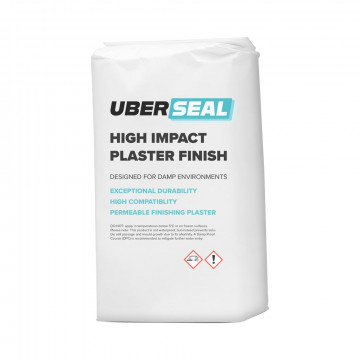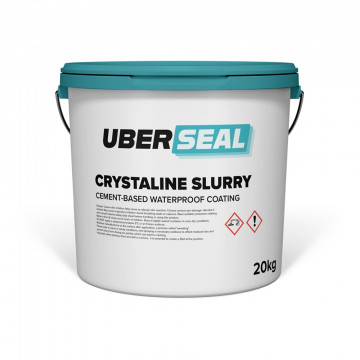UberSeal Flexible Tanking Slurry
Coming as a two-component product, UberSeal Flexible Tanking Slurry offers a waterproof, highly adaptable coating system ideal for brickwork, masonry, and concrete surfaces. Crafted from a mixture of Portland cements, select aggregates, and a potent liquid polymer to provide it with more flexible properties, this slurry delivers a reliable waterproofing solution for use both above and underground. It adheres exceptionally well to building materials and can be applied to wet surfaces without compromise. Its inherent flexibility makes it perfect for both internal and external areas prone to movement.
COVERAGE RATES
A 20kg unit will provide a coverage of 5m², at two coats
Please note: rates are also dependant on the porosity of the surface.
APPLICATION GUIDE
Preparation
Ensure all surfaces are clean, stable, and free of loose materials, dust, laitance, or old coatings, revealing the underlying brickwork, masonry, or concrete. You should achieve a properly keyed surface through appropriate preparation methods like grit blasting, high-pressure jet washing, or shot blasting as needed. If applicable, remove any embedded foreign objects such as nails or timber, rake out loose joints to 20mm, and clean out any voids.
After cleaning, fill these areas flush with UberSeal Fillet Seal before tanking. Stop any physical water ingress with UberSeal Waterstop before applying UberSeal Flexible Tanking Slurry.
Priming
Mix UberSeal SBR Additive with clean water at a 1:1 ratio (by volume). Apply the mixture onto the surface using a roller, brush, or spray. Wait for 30 minutes until the primer feels tacky to the touch.
Application
- Shake the liquid component before allowing it to settle. Once settled, pour the liquid into an empty bucket.
- Using a Mortar Drill and Paddle, slowly start to add 100% of the powder into the bucket. Do this slowly to prevent dust generation. Slowly increase the drill speed and mix for 2 minutes, ensuring all powder is incorporated.
- Mix for a further 1 minute to remove any lumps.
- Clean water can now be mixed in to achieve the desired consistency. A maximum of 0.5L of tap water can be added without it affecting the crack bridging properties.
- The liquid/powder ratio should be 1:3. If smaller batches are required, make sure the full amount and ratio are adhered to so it may maintain its integrity.
- Apply the first coat using a brush, horizontally down to the floor and across any fillets.
- The second coat must be applied when the first has had sufficient time to cure (up to 5 hours at 20°C).
- Apply the second coat in a vertical direction, taking care not to damage the first layer.
- Ensure not to exceed 24 hours between applying the first and second coats.
- If the tanking is not extended to the floor, spread the coating at least 250mm across the floor before ending.
- When connecting floors to walls or at corners, create a fillet for optimal sealing, referring to the specific data sheet for guidance.
USEFUL INFORMATION
- DO NOT: apply in temperatures below 5°C or on frozen surfaces.
- Moisture naturally forms on the surface after application, a process called "sweating". Please note: in warm or windy conditions, mist spraying is necessary outdoors to offset moisture loss and prevent slurry from drying too quickly, which can lead to cracking.
- Important: when joining a floor and wall or corners, it is essential to create a fillet at the junction.












